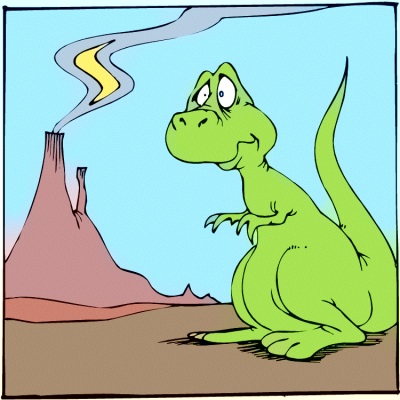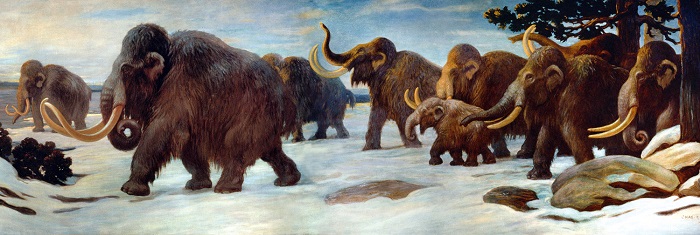Observations of Geological Evidence for the Death of "the World that then Was"

The geologic and fossil records are the surviving evidence, written in stone, that testify to the truth that the Earth is very old and was populated long before the seven days of Genesis chapter one. But does that record provide evidence of the sudden end of the old world by a universal destructive event before the seven days and before Noah's flood?
"And the earth was without form, and void; and darkness was upon the face of the deep. And the Spirit of God moved upon the face of the waters."
(Genesis 1:2 KJV)
This certainly would appear to be the case. Throughout the geologic record there is evidence of mass extinction and geologic catastrophes. The theory that a giant asteroid struck the earth about 65 million years ago and thus precipitated the demise of the dinosaurs is now widely accepted as a fact. As recently as just a few years ago, that theory was scoffed at until the remains of an ancient crater were found in the Yucatan. That same school scoffed at Alfred Wegner's theory about plate tectonics "The Origin of the Continents and Oceans" back in the early days of the 20th century, but today that theory is considered the grand unifying theory of the geological sciences.
One of the greatest remaining mysteries to modern geology is found within the most recent episode of mass destruction which occurred in the geological age called the Pleistocene; the age just before the Holocene, which is the age of Man. This extinction event appears to be linked with the Ice Age. The evidence consists of vast "animal cemeteries" found in many places around the world, which seem to show a catastrophic and sudden destruction of life all across the planet only a few thousand years ago.
This evidence was documented by many back in the 19th century, but this evidence was mostly ignored by the leading scientists of the day because it did not fit into the prevailing scientific paradigm. This evidence is still mostly ignored today, although the Young Earth Creationists have seized upon it as proof of Noah's flood. It is actually proof of the flood which happened just before the time of Genesis 1:2, the time when all life on the surface of the Earth had been wiped out.
The best collection of the documentation on this event can be found within the paper "Catastrophe and Reconstitution" by the late Arthur Custance. I recommend you take time to read this paper. For those of you in a hurry, here is a sampling of references by several scientists cited within that paper:
On the general topic of animal cemeteries, one source wrote:
"The great problem for geological theories to explain is that amazing phenomenon, the mingling of the remains of animals of different species and climates, discovered in exhaustless quantities in the interior parts of the earth so that the exuviae of those genera which no longer exist at all, are found confusedly mixed together in the soils of the most northerly latitudes. . . The bones of those animals which can live only in the torrid zone are buried in the frozen soil of the polar regions." Penn, Granville, A Comparative Estimate of the Mineral and Mosaical Geologies, Vol. II, 2nd ed., London, 1825, p. 81.
In a reference to a site in Italy another wrote:
"In this sandy matrix bones were found at every depth from that of a few feet to a hundred feet or more. From the large and more apparent bones of the elephant, the rhinoceros, the megatherium, the elk, the buffalo, the stag, and so forth, naturalists were led by the elaborate studies of Cuvier and other comparative anatomists to the remains of the now living bear, tiger, wolf, hyena, rabbit, and finally the more minute remains even of the water rat and the mouse. In some places so complete was the confusion . . . that the bones of many different elephants were brought into contact, and on some of them even oyster shells were matted." Fairholme, George, New and Conclusive Physical Demonstrations of the Fact and Period of the Mosaic Deluge, n.p., 1837.
In one of his early writings, even Charles Darwin commented on what he saw in the fossils of South America:
"The mind is at first irresistibly hurried into the belief that some great catastrophe has occurred. Thus, to destroy animals both large and small in South Patagonia, in Brazil, in the Cordillera, in North America up to the Behring Straits, we must shake the entire framework of the globe. Certainly no fact in the long history of the world is so startling as the wide extermination of its Inhabitants."
Darwin, Charles, Journal of Researches, Ward Lock, New York. 1845, p. 178.
A contemporary of Darwin commented:
"We live in a zoologically impoverished world, from which all the hugest and fiercest, and strangest forms have recently disappeared.... Yet it is surely a marvelous fact, and one that has hardly been sufficiently dwelt upon this sudden dying out of so many large mammalia not in one place only but over half the land surface of the globe."
"There must have been some physical cause for this great change, and it must have been a cause capable of acting almost simultaneously over large portions of the earth's surface." Wallace, Alfred Russell, Geographical Distribution of Animals, Vol. 1, Hafner, New York, 1876, pp. 150, 151.
From a book titled "The Mammoth and the Flood" by Sir Henry Howorth, the following are excerpts about data he gathered first hand in Siberia:
"In the first place, it is almost certain in my opinion that a very great cataclysm or catastrophe occurred . . . by which the mammoth with his companions was overwhelmed over a very large part of the earth's surface. This catastrophe, secondly, involved a widespread flood of waters which not only killed the animals but also buried them under continuous beds of loam or gravel. Thirdly, that the same catastrophe was accompanied by a very sudden change of climate in Siberia, by which the animals that had previously lived in fairly temperate conditions were frozen in their flesh under the ground and have remained there ever since."
"When the facts are stated, they are of such a nature as to be almost incredible and they are drawn from the works of such men as Wrangell, Strahlenberg, Witzen, Muller, Klaproth, Avril, Erman, Hedenstrom, Betuschef, Bregne, Gemlin, Brandt, Antermony, Liachof, Kusholof, Chamisso, Maljuschkin, Ides, Baer, Schmidt, Bell, Tatishof, Middendorf, von Schrenck, Olders, Laptef, Sarytschef, Motschulsky, Schtscukin, Maydell, besides the official documents of the Russian Government." Howorth, Sir Henry, Thc Mammoth and thc Flood: Uniformity and Geology, London, 1887. p. 47.
Henry Howorth had this to say on animal cemeteries:
"The most obvious cause we can appeal to as occasionally producing mortality on a wide scale among animals is a murrain or pestilence, but what murrain or pestilence is so completely unbiased in its actions as to sweep away all forms of terrestrial life, even the very carriers of it--the rodents-- including the fowls of the air, the beasts of the field, elephants, tigers, rhinoceroses, frogs, mice, bison and snakes, landsnails, and every conceivable form of life, and this not in one corner only but, as far as we know, over the whole of the two great continents irrespective of latitude or longitude."
"The fact of the bones occurring in great caches or deposits in which various species are mixed pell-mell is very important, and it is a fact undenied by geologists that whenever we find such a locality in which animals have suffered together in a violent and instantaneous destruction, the bones are invariably mixed and, as it were, 'deposited' in a manner which could hardly be explained otherwise than by postulating the action of great tidal waves carrying fishes and all before them, depositing them far inland with no respect to order." Howorth, Sir Henry, Thc Mammoth and thc Flood: Uniformity and Geology, London, 1887, p.180.
In concluding remarks Howorth had this to say:
"If animals die occasionally (in large numbers) from natural causes, different species do not come together to die, nor does the lion come to take his last sleep with the lamb! The fact of finding masses of animal remains of mixed species all showing the same state of preservation, not only points to a more or less contemporary death, but is quite fatal to the theory that they ended their days peacefully and by purely natural means."
"If they had been exposed to the air, and to the severe transition between mid-winter and mid-summer, which characterizes Arctic latitudes, the mammoths would have decayed rapidly. But their state of preservation proves that they were covered over and protected ever since."
"It is almost certain in my opinion that a very great cataclysm or catastrophe occurred by which the mammoth and his companions were overwhelmed over a very large part of the earth's surface. And that the same catastrophe was accompanied by a very great and sudden change of climate in Siberia, by which the animals which had previously lived in fairly temperate conditions were frozen . . . and were never once thawed until the day of their discovery. No other theory will explain the perfect preservation of these great elephants."
In summarizing his comments on Howorth and the other sources cited, Arthur Custance made these observations:
"Howorth even recorded a whale which was found entombed with the elephants, a discovery which Pallas confirmed--mentioning also buffalo in situ with the heads of large fishes."
"In spite of the fact that many of these authorities would now be considered quite out of date, so that their interpretations would almost certainly be rejected, the evidence itself remains undeniable; and it is difficult to explain it satisfactorily in any other way."
"Such, then, is the kind of evidence which is to be found all over the world of the sudden death of an enormous number of animals of very recent and modern times. Some of these creatures died in latitudes that were almost at once plunged into an Ice Age which preserved them by freezing. Some of them died in more temperate zones and were accumulated by the action of torrents of water sweeping hither and yon as the earth reeled, before the waters had been sufficiently gathered together in one place to expose the dry land. And, finally, some were accumulated and rammed together forcibly and indiscriminately into clefts in the rocks which served to sieve them out of the draining waters."
"The suddenness of the event is everywhere attested, in the Arctic by the extraordinary state of preservation of mammoths and other creatures, and in the more temperate zones by the very fact that predators and preyed upon came to a sudden end together. Even within the waters, the movements of silt and water-washed materials were sometimes so sudden and overwhelming that fishes were trapped before they had the few seconds necessary to react in a characteristic defensive way. Some bivalved forms, in fact, were overwhelmed so rapidly that they did not have time to close."
"Furthermore, we may conclude, I think, that the catastrophe which was worldwide profoundly affected world climate."
Custance, Arthur, "Catastrophe and Reconstitution" Custance Library Doorway Papers & Books on Interface between Faith and Science
Although I do not personally subscribe to all the doctrines which the late Arthur Custance put forth in his vast collection of papers, I do feel that he presented a good argument for the evidence of a great universal catastrophe in the days before true man was placed upon the earth. Although the exact mechanics of the total event are not yet understood, there is ample supporting evidence for a vast and violent flood as the destructive agent; a flood BEFORE the flood of Noah's days. This would be consistent with the gap of Genesis 1:2 and the condition of the earth at that point in time.
Lastly, there is a more contemporary observation that I extracted from a published interview and story by Linda Moulton Howe of "EARTHFILES" and is reprinted here, in part, by written permission of the copyright holder. The full article, including graphics, is available by subscription.
12,000-Year-Old Human Hair DNA Has No Match With Modern Humans
Copyright 2001 by Linda Moulton Howe - All Rights Reserved.
October 28, 2001 Woodburn, Oregon - Human hair dating back to the last Ice Age ten to twelve thousand years ago was discovered in 1999 at an archaeological dig in Woodburn, Oregon between Salem and Portland. The Ice Age site is filled with the bones of elephants, sloths, condors and a bird with a 14-foot wingspan. The unidentified human hairs were found perfectly preserved a few feet underground and had enough follicles for DNA analysis. This week I talked with geology professor emeritus, William Orr, at the University of Oregon, about DNA efforts to match the Ice Age hair to any living hominoid species on earth today.
Evacuation units at Woodburn, Oregon Ice Age archaeological site were prepared and excavated. Some units were skim shoveled and then trowled so that animal limbs and fauna could be extracted without harm.William Orr, Ph.D., Professor Emeritus in Geology, University of Oregon, and Director of the State Museum of Paleontology, Eugene, Oregon: "You can identify human hair, forensic criminologist types, can identify human hair from a single strand because of the granules and color and all that kind of stuff. You can distinguish human hair from all other hair just from a little piece of follicle."
DNA analyses of hair follicles found at the site have so far failed to find a match with any known human racial type living on earth today.
"We found several strands of human hair, long pieces a foot and a half long, black, long pieces of hair. And then if you can find the root of the hair that still has a follicle, you can do DNA on it. So researchers immediately sent the (Ice Age) hair off to a lab and they began to extract the DNA. Some of it was not so good, but a lot of it was well preserved in the oxygen-poor bogs of Woodburn. The geneticists found the hair didn't match any Asian hair DNA. It didn't match African, European. It didn't match anything. Dogma would be that Ice Age humans along the west coast of the United States would be from a Japanese population that is alleged to have come over the Bering Sea back twelve to thirteen thousand years ago."
"So right now we have DNA we can't track. We can't figure out what it's from. Apparently from a population we don't have today. They are gone. And it's only 11,000 or 12,000 years old. About that time period, there was a huge crisis in animals. The larger animals all disappeared and they disappeared in a wave. They disappeared first in British Columbia and then in Washington, Oregon, California and right on down. Some were still around until 10,000 years ago in Tierra del Fuego. So, it was like a wave of extinction at the rate of about 10 miles per year."
Howe: "SO THERE IS A MYSTERY ABOUT WHAT KILLED OFF ALL OF THESE MAMMALS IN WAVES TEN OR TWELVE THOUSAND YEARS AGO?"
Orr: "Oh, yes. In fact for my money, it's far more profound than the crisis that killed off the dinosaurs and a few other animals at 66 million years ago. This (western North American) was more sudden, more pervasive. It kind of selectively took the large animals in a short period of time."
Howe: "HOW DEEP DOWN WERE THE HAIRS FOUND?"
Orr: "The deepest ones were from ten to twelve feet, but a lot of them were from much shallower depths. It's an old stream bed and we just took a little auguring device to core down and began getting well-preserved hair out of the clays. The Woodburn stuff it's like putting it in a deep freeze, or a glad bag and freezing it. It's an anoxic environment (no oxygen). You wouldn't believe the insects come out with colors still. And as you watch them, the color changes from the iridescent blue-green back to a kind of dull black, just in the exposure as they oxidize before your eyes. Even the butterflies come out with pigment and then they just change color."
Howe: "IT'S ALMOST AS IF THEY WERE QUICK FROZEN?"
Orr: "Almost."
Copyright 2001 by Linda Moulton Howe
All Rights Reserved.

In reference to the remarks about the remains being preserved almost as if "Quick Frozen" this is extremely interesting, as such is consistent with the finding of Wooly Mammoths from the same period in time whose remains indicate they too appear to have been quick frozen (many links can be found on the Internet which document that particular find). By interpretation, in the context of the Gap Theory doctrine, this is compelling evidence of a sudden and catastrophic end to life on this planet in the old world. If the sun (indeed the entire cosmos) of the old world suddenly went dark, by whatever agency, these findings would be consistent with such an event and the conditions on the Earth before the regeneration of the heavens and earth (Genesis 1:2).
A nuclear scientist, Richard Firestone, reported finding "impact regions" on mammoth tusks found in Gainey, Michigan, which were caused by high velocity magnetic particles rich in elements like titanium and uranium. Firestone says that based on his discovery of similar material at a North American Clovis site, he estimates that comets (possibly produced by a relatively close supernova) struck the solar system during the Clovis period, roughly 13,000 years ago.
Disclaimer: External Links
from this website are for instructional or promotional purposes and do not
constitute an endorsement
by the The Bible, Genesis & Geology Ministry.
All original text © 1997 -
2021
Gaines R.
Johnson, D.D., D.Th.
The Bible, Genesis & Geology Ministry
Materials from this site may
be freely copied to paper for personal use or church Bible studies.
They may not be reproduced
elsewhere on the Internet, for either personal or commercial use, without
the express written permission of this Ministry.
Are you saved? Are you Sure? Click the image below for the Gospel Truth about the Lord Jesus Christ in your native language!


